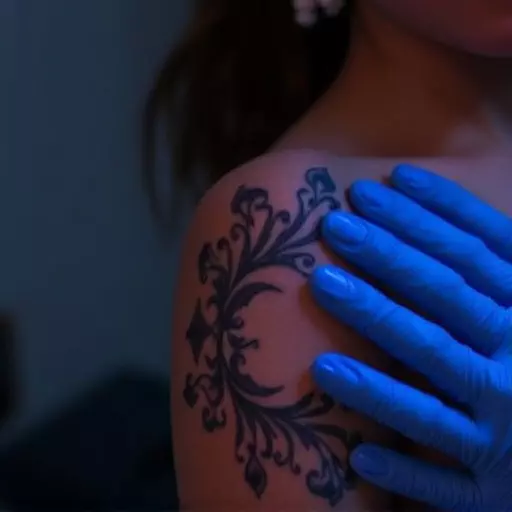This text explores tattoo lightening trends in Toledo, highlighting laser and non-laser methods. Laser treatments use precise wavelengths to fragment ink over multiple sessions, offering speed and targeted results but with potential side effects like temporary skin irritation. Non-laser techniques, including creams and chemical peels, are gentler on the skin but require more time and sessions for effective fading. Both options have distinct advantages; laser is quicker while non-laser methods are safer for certain skin types. In Toledo, consulting professionals at reputable clinics ensures safe, effective tattoo lightening with proper aftercare guidance. The timeline varies, with lasers achieving 50-75% ink reduction in a few sessions, and non-lasers taking 6-12 weeks for noticeable fading.
“Considering tattoo lightening in Toledo? This comprehensive guide unravels the entire process, from understanding your options like laser and non-laser tattoo lightening, to step-by-step procedures that ensure safe and effective results.
Learn about the benefits of laser tattoo lightening, explore alternative non-laser methods, and discover a realistic timeline for fading those tattoos. We also delve into crucial safety precautions and aftercare tips to help you make an informed decision on your journey towards tattoo-free skin.”
- Understanding Tattoo Lightening: A Comprehensive Overview
- The Tattoo Lightening Process: Step-by-Step Guide
- Laser Tattoo Lightening: Benefits and Considerations
- Non-Laser Tattoo Lightening Options: Alternatives to Consider
- Timeline and Expectations: How Long Does it Take?
- Safety Precautions and Aftercare for Tattoo Lightening
Understanding Tattoo Lightening: A Comprehensive Overview

Tattoo lightening is a process that has gained significant popularity in recent years, offering individuals the chance to reduce or even remove unwanted ink from their bodies. This procedure involves breaking down and eliminating pigment particles within the skin, leading to a lighter tattoo appearance or complete fading. The market offers various methods, primarily categorized as laser and non-laser lightening techniques.
Laser tattoo lightening uses specific wavelengths of light to target and fragment the tattoo ink, allowing the body’s natural processes to eliminate them. It is considered a safe and effective approach but may require multiple sessions for optimal results. On the other hand, non-laser methods employ topical creams, chemical peels, or other techniques to fade tattoos. These alternatives might be more accessible and affordable but could potentially cause side effects and may not deliver the same level of precision as laser treatments.
The Tattoo Lightening Process: Step-by-Step Guide

The Tattoo Lightening Process: Uncovering the Steps
Tattoo lightening is a carefully orchestrated process that involves several stages to achieve desired results, whether using laser or non-laser methods. It begins with a thorough consultation where a professional assesses the tattoo’s color, age, and size to determine the best approach. For laser lightening, a specialized machine is calibrated to target the specific inks used in the tattoo, emitting pulses of light that break up the pigment. This method requires multiple sessions spaced weeks apart to ensure safe and effective fading.
Non-laser methods take a different tack, often employing topical creams or natural ingredients known for their bleaching properties. These solutions are applied topically, carefully avoiding the surrounding skin. It’s crucial during this step to follow instructions precisely and be patient, as complete tattoo lightening can take several months. Each method offers unique advantages and considerations, with laser providing faster results for more complex tattoos while non-laser approaches are often gentler on the skin and suitable for lighter ink fades.
Laser Tattoo Lightening: Benefits and Considerations

Laser Tattoo Lightening offers several significant advantages when compared to traditional non-laser methods of tattoo removal or lightening. The process utilizes targeted laser beams that penetrate the skin and break down pigment particles, allowing them to be absorbed by the body’s natural processes. This approach is highly effective for reducing the appearance of tattoos over time, often resulting in faded or nearly invisible scars. One key benefit is its precision; lasers can target specific colors and sizes of tattoos, minimizing damage to surrounding skin.
However, it’s essential to consider potential drawbacks. Laser treatments can be expensive, and multiple sessions are usually required for optimal results. Side effects may include temporary redness, swelling, and discomfort during the procedure. Additionally, not all tattoo inks respond equally well to laser lightening, with certain colors proving more challenging to remove than others. Choosing a reputable clinic in Toledo, OH, specializing in laser tattoo lightening can ensure safer, more effective outcomes, employing state-of-the-art technology and experienced professionals to navigate the tattoo lightening process.
Non-Laser Tattoo Lightening Options: Alternatives to Consider

When considering tattoo lightening in Toledo, it’s essential to explore various options beyond laser treatments, especially if you’re seeking alternatives or have specific concerns. Non-laser tattoo lightening methods offer promising results for those looking to reduce the intensity of their tattoos without the potential side effects associated with lasers.
One popular non-laser option is chemical peeling, which involves applying topical agents to gradually remove layers of skin and lighten the tattoo. This process can be effective for older tattoos but may require multiple sessions. Another approach is microdermabrasion, a mechanical exfoliation technique that removes the upper layer of skin, leading to reduced ink visibility. For more targeted treatments, certain creams containing hydroquinone or other bleaching agents can be applied topically, though these should be used under professional guidance due to potential skin irritation.
Timeline and Expectations: How Long Does it Take?

The timeline for tattoo lightening can vary greatly depending on several factors such as the size and color of the tattoo, the type of lightening process used, and how well a person’s skin heals. Generally, non-laser tattoo lightening methods like chemical peels or topical creams take anywhere from 6 to 12 weeks to show noticeable results. The process involves multiple sessions spaced several weeks apart to ensure safe and effective fading without damaging the skin.
Laser tattoo lightening, on the other hand, offers quicker results, typically reducing tattoo ink by 50-75% in just a few sessions. A single laser session might only last for about 20-30 minutes, but multiple sessions—spaced 4-6 weeks apart—are often required to achieve the desired level of lightening. It’s crucial to remember that complete removal is not guaranteed, and some ink may remain visible after treatment.
Safety Precautions and Aftercare for Tattoo Lightening

When undergoing tattoo lightening, whether via laser or non-laser methods in Toledo, safety precautions are paramount to prevent complications and ensure successful results. Always consult a reputable professional who uses approved equipment and follows strict hygiene protocols. Before treatment, disclose your medical history, current medications, and any allergies to ensure the process is suitable for you.
Post-lightening aftercare plays a crucial role in healing and fading results. Following your artist’s guidance on care instructions is essential. Typically, this includes keeping the treated area clean, using recommended moisturizers or ointments, and avoiding direct sunlight or tanning beds. Be mindful of potential side effects like redness, swelling, or mild pain, which are normal parts of the tattoo lightening process.


